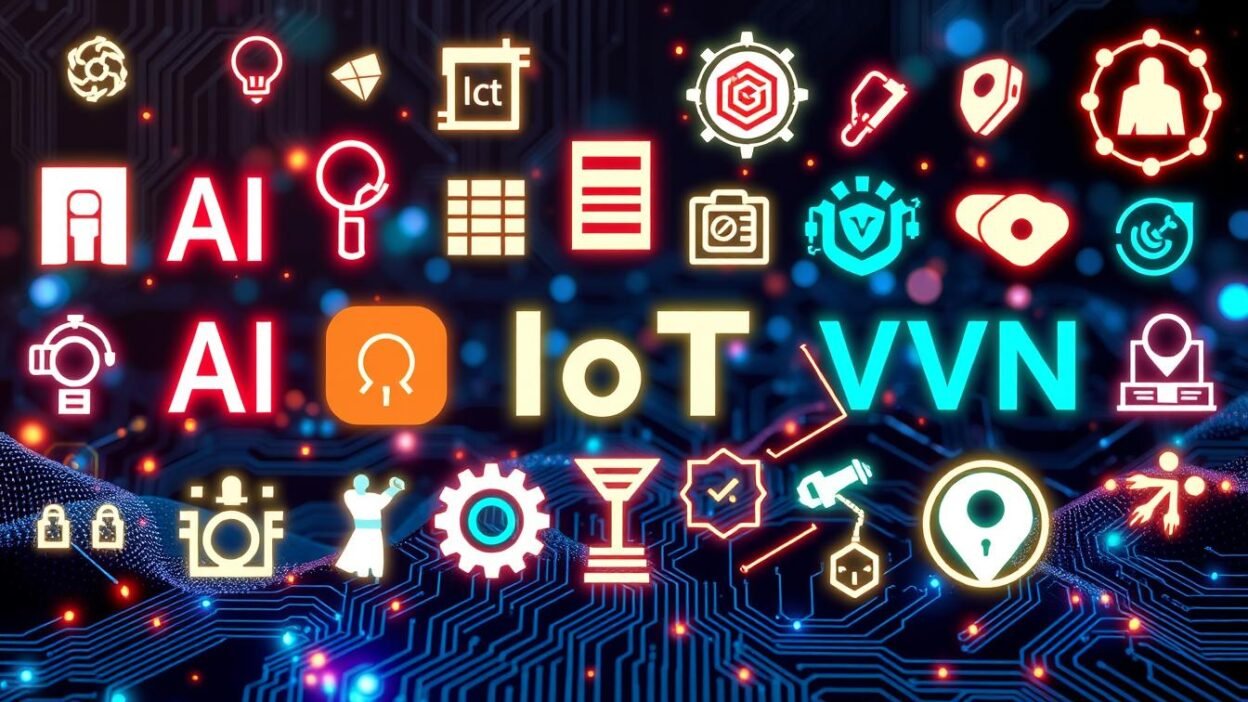Ready to tackle ICT terms in the UGC NET Paper 1 exam? Mastering these abbreviations can give you an edge. Let’s explore why this knowledge is crucial for success.
This guide covers essential ICT abbreviations for your UGC NET journey. Understanding these terms will boost your exam performance. It’ll also deepen your grasp of ICT in education.
Key Takeaways
- Familiarize yourself with common ICT abbreviations like CPU, RAM, ROM, LAN, WAN, WWW, FTP, HTTP, and HTML.
- Understand how ICT knowledge is crucial for the UGC NET Paper 1 exam and your teaching career.
- Discover the significance of various ICT terms in the context of the education sector.
- Enhance your overall understanding of technological concepts and their practical applications.
- Gain a competitive edge in the UGC NET examination by mastering ICT terminology.
Introduction to ICT Terminology in NET Examination
The UGC NET assesses candidates’ aptitude for academic and research positions. It includes Information and Communication Technology (ICT) terminology. This tests research aptitude, communication skills, and logical reasoning abilities.
Understanding the Role of ICT in UGC NET
UGC NET values ICT knowledge in modern academics and research. Candidates should know common ICT abbreviations like CPU, RAM, ROM, LAN, WAN, WWW, FTP, HTTP, and HTML.
This knowledge shows technical skills and ability to navigate the digital landscape. It’s crucial for current research and teaching practices.
Why ICT Knowledge Matters for Aspirants
Strong ICT knowledge helps candidates excel in UGC NET. It enhances research aptitude by enabling effective use of digital tools and resources.
ICT skills boost communication skills for presenting research findings using proper technological jargon. They also strengthen logical reasoning abilities for complex problem-solving in the exam.
Mastering ICT terminology improves overall UGC NET performance. It shows readiness for academic and research roles in the digital age.
UGC NET Paper 1 Important Topics
UGC NET Paper 1 tests candidates on data interpretation, educational psychology, and educational philosophy. ICT terminology is crucial, but the exam covers other essential areas too.
Data interpretation assesses the ability to analyze and draw insights from various types of data. This includes interpreting graphs, charts, tables, and other visual information.
Educational psychology evaluates knowledge of learning theories and cognitive development. It also covers psychological factors that influence the educational process.
Educational philosophy tests understanding of teaching methods and educational principles. Candidates must grasp these concepts and their real-world applications in education.
| Topic | Focus Area |
|---|---|
| Data Interpretation | Analyzing and interpreting data from various sources, including graphs, charts, and tables. |
| Educational Psychology | Understanding learning theories, cognitive development, and psychological factors in education. |
| Educational Philosophy | Comprehending educational goals, teaching methodologies, and the principles underlying educational systems. |
Knowing these key topics helps UGC NET Paper 1 aspirants prepare well. They can tackle the wide range of content covered in the exam.
Basic Computer Hardware Abbreviations
Knowing common ICT abbreviations is vital for the UGC NET exam. These terms build a strong base for understanding tech in education and environmental studies. Mastering them will boost your knowledge significantly.
CPU and Processing Components
The CPU is the brain of a computer. It runs instructions and does calculations. Here are some key CPU-related terms:
- CPU – Central Processing Unit
- RAM – Random Access Memory
- ROM – Read-Only Memory
- ALU – Arithmetic Logic Unit
- CU – Control Unit
Memory and Storage Terms
Computers use various types of memory and storage. These terms help grasp data management in education and environmental issues.
| Abbreviation | Term |
|---|---|
| HDD | Hard Disk Drive |
| SSD | Solid-State Drive |
| USB | Universal Serial Bus |
| SD | Secure Digital |
Input/Output Device Terminology
Knowing I/O devices helps navigate tech in education and environmental fields. Here are some common I/O device terms:
- KB – Keyboard
- Mouse
- LCD – Liquid Crystal Display
- HDMI – High-Definition Multimedia Interface
- LAN – Local Area Network
- WAN – Wide Area Network
Learning these terms boosts your ICT knowledge for the UGC NET exam. It helps in understanding tech concepts in education and environmental studies. This knowledge is crucial for success in these fields.
Network and Internet Related Terms
The UGC NET Paper 1 exam tests your knowledge of computer networks and internet terms. These concepts are vital for teaching and research aptitude sections. They also help understand ICT in education.
Key network and internet-related abbreviations often appear in the UGC NET Paper 1. Let’s explore some of these important terms.
- LAN (Local Area Network): A computer network that interconnects devices within a limited geographical area, such as a home, school, or office.
- WAN (Wide Area Network): A network that spans a large geographical area, such as a country or continent, allowing for the interconnection of multiple LANs.
- WWW (World Wide Web): The global information system that utilizes the internet to access and share information through websites and web-based applications.
- FTP (File Transfer Protocol): A standard network protocol used for transferring files between computers over the internet.
- HTTP (Hypertext Transfer Protocol): The foundation of data communication on the World Wide Web, defining how messages are formatted and transmitted.
- HTML (Hypertext Markup Language): The standard markup language used to create and structure web pages, providing the basic building blocks for internet content.
These UGC NET Paper 1 important topics are crucial for understanding modern educational and research activities. Knowing these terms helps NET candidates tackle ICT-focused questions with confidence.
| Abbreviation | Meaning | Relevance to UGC NET Paper 1 |
|---|---|---|
| LAN | Local Area Network | Understanding the basics of computer networking and its role in educational institutions |
| WAN | Wide Area Network | Comprehending the larger-scale network infrastructure that connects educational institutions and research centers |
| WWW | World Wide Web | Knowing the foundational technology behind the global information system and its educational applications |
| FTP | File Transfer Protocol | Understanding the protocols used for sharing and exchanging digital resources in educational and research settings |
| HTTP | Hypertext Transfer Protocol | Familiarizing with the standard for web-based communication and its role in educational technology |
| HTML | Hypertext Markup Language | Recognizing the basic language used to create and structure web-based educational content and resources |
Mastering these network and internet-related terms helps UGC NET aspirants show their teaching and research aptitude. It proves their grasp of modern educational practices and research methods.
“In the digital age, a strong grasp of network and internet technologies is essential for educators and researchers to effectively leverage the power of information and communication technologies in their work.”
Software and Programming Abbreviations
Software and programming are vital in ICT. They enable effective communication, logical reasoning, and data interpretation. UGC NET aspirants should know common abbreviations in this field.
Operating System Terms
Operating systems (OS) manage a computer’s hardware and resources. They are the foundation of computer software. Here are some common OS abbreviations:
- OS – Operating System
- PC – Personal Computer
- MAC – Macintosh Operating System
- DOS – Disk Operating System
- UNIX – A family of multi-tasking, multi-user operating systems
- GUI – Graphical User Interface
Programming Language Acronyms
Programming languages are key to software development. They allow developers to create innovative applications. Knowing these acronyms can boost your skills:
- C – C Programming Language
- C++ – C Plus Plus
- JAVA – Java Programming Language
- PYTHON – Python Programming Language
- HTML – Hypertext Markup Language
- CSS – Cascading Style Sheets
Development Tools and Platforms
NET candidates should know abbreviations for software development tools and platforms. These are crucial for creating complex applications.
| Abbreviation | Full Form | Description |
|---|---|---|
| IDE | Integrated Development Environment | A software application that provides a comprehensive environment for writing, testing, and debugging code |
| API | Application Programming Interface | A set of protocols, tools, and standards for building software applications |
| SDK | Software Development Kit | A collection of software development tools in one installable package |
Learning these abbreviations can improve your skills. It can boost your communication skills, logical reasoning, and data interpretation. This knowledge will help you excel in the UGC NET exam.
Data Communication Terminology
Understanding data communication terms is vital in modern educational psychology, educational philosophy, and educational sociology. These acronyms form the basis of information and communication technologies (ICT) in education. They power today’s learning environments and shape how we teach and learn.
Data transmission relies on key hardware concepts. CPU (Central Processing Unit), RAM (Random Access Memory), and ROM (Read-Only Memory) are essential components. These parts create the digital foundation for smooth communication in education.
Networking language is equally important. LAN (Local Area Network), WAN (Wide Area Network), and WWW (World Wide Web) describe connected digital systems. They enable information sharing among educators, students, and schools.
Data flow protocols play a crucial role too. FTP (File Transfer Protocol), HTTP (Hypertext Transfer Protocol), and HTML (Hypertext Markup Language) govern communication standards. Understanding these helps maximize technology’s potential in education fields.
| Abbreviation | Meaning |
|---|---|
| CPU | Central Processing Unit |
| RAM | Random Access Memory |
| ROM | Read-Only Memory |
| LAN | Local Area Network |
| WAN | Wide Area Network |
| WWW | World Wide Web |
| FTP | File Transfer Protocol |
| HTTP | Hypertext Transfer Protocol |
| HTML | Hypertext Markup Language |
Knowing these data communication terms is key for education professionals. It helps them use technology effectively and create innovative learning spaces. This knowledge empowers educators to enhance teaching and learning experiences.
Web Technologies and Protocols
Understanding web abbreviations is vital for UGC NET exam prep. Terms like HTTP, HTML, and CSS are key to modern education and research. Knowing these technologies shows a deep grasp of ICT, a crucial part of UGC NET Paper 1.
Common Internet Protocols
HTTP is the backbone of the World Wide Web. It enables data exchange between web servers and clients. FTP is another key protocol for uploading and downloading files online.
These protocols are essential to grasp web infrastructure. They’re highly relevant for UGC NET Paper 1 exams.
Web Development Standards
HTML, CSS, and JavaScript are the main web development standards. They control web page structure, look, and interactivity. Knowing these is crucial for aspirants.
These standards are used in educational research and online learning platforms. They’re also key to web apps relevant to the UGC NET curriculum.
| Abbreviation | Description |
|---|---|
| HTTP | Hypertext Transfer Protocol |
| FTP | File Transfer Protocol |
| HTML | Hypertext Markup Language |
| CSS | Cascading Style Sheets |
| JS | JavaScript |
Mastering these ICT abbreviations is key for UGC NET Paper 1 aspirants. They support environmental issues and tech advances shaping modern education and research methods.
“Understanding web technologies and protocols is not just about passing the UGC NET exam, but about equipping ourselves with the digital literacy necessary to thrive in the 21st-century educational landscape.”
Mobile Computing Abbreviations
Mobile devices are changing education. UGC NET aspirants must know common mobile computing abbreviations. These terms show teaching, research, and communication skills. They also reflect understanding of modern teaching tools.
UGC NET candidates should know these key mobile computing abbreviations:
- BYOD (Bring Your Own Device)
- EPUB (Electronic Publication)
- GPS (Global Positioning System)
- LTE (Long-Term Evolution)
- NFC (Near-Field Communication)
- QR Code (Quick Response Code)
- SIM (Subscriber Identity Module)
- SSID (Service Set Identifier)
- UHF (Ultra-High Frequency)
- VoIP (Voice over Internet Protocol)
- WLAN (Wireless Local Area Network)
These abbreviations cover various mobile computing technologies. They include device connectivity, data transfer, and wireless networking. Understanding these terms helps UGC NET aspirants demonstrate their skills during exams.
| Abbreviation | Meaning | Application |
|---|---|---|
| BYOD | Bring Your Own Device | Policies that allow students and staff to use their personal mobile devices for educational purposes |
| GPS | Global Positioning System | Location-based services and navigation on mobile devices |
| NFC | Near-Field Communication | Wireless data transfer and device pairing on mobile devices |
| WLAN | Wireless Local Area Network | Wireless internet connectivity for mobile devices in educational institutions |
“The future of education lies in the seamless integration of mobile technologies, empowering both teachers and students to explore new frontiers of knowledge and collaboration.”
Cloud Computing and Storage Terms
Cloud computing and storage are vital tools in today’s tech world. They help researchers, educators, and students in many ways. Let’s explore key cloud-related terms and their importance.
These tools are crucial for logical reasoning and data interpretation. They also help navigate the educational landscape effectively.
Cloud Service Models
The three main cloud service models are:
- SaaS (Software as a Service): This model provides access to software applications over the internet, eliminating the need for local installation and maintenance.
- PaaS (Platform as a Service): This platform offers a complete environment for developing, testing, and deploying applications, without the complexities of managing the underlying infrastructure.
- IaaS (Infrastructure as a Service): This service provides virtualized computing resources, such as servers, storage, and networking, allowing users to scale their infrastructure as needed.
Storage Technologies
Cloud storage tech is key for data storage and sharing in education. It also helps with collaboration.
Here are some important terms to know:
- NAS (Network Attached Storage): A specialized file-level computer data storage server connected to a computer network, providing centralized data storage and management.
- SAN (Storage Area Network): A dedicated high-speed network that provides access to consolidated, block-level data storage.
- RAID (Redundant Array of Independent Disks): A data storage virtualization technology that combines multiple disk drive components into a logical unit, improving performance, reliability, and/or capacity.
Knowing these terms helps educators and researchers use cloud tech better. It can boost logical reasoning and data interpretation skills.
These tools also support educational psychology projects in various fields.
| Cloud Service Model | Description |
|---|---|
| SaaS (Software as a Service) | Provides access to software applications over the internet, eliminating the need for local installation and maintenance. |
| PaaS (Platform as a Service) | Offers a complete environment for developing, testing, and deploying applications, without the complexities of managing the underlying infrastructure. |
| IaaS (Infrastructure as a Service) | Provides virtualized computing resources, such as servers, storage, and networking, allowing users to scale their infrastructure as needed. |
Digital Security and Privacy Terms
Digital security and privacy are crucial in educational technology. Educators, researchers, and students rely on ICT for learning and knowledge-sharing. Understanding key terms in these areas is essential.
VPN (Virtual Private Network) is a vital digital security term. It creates secure, encrypted connections between devices. This allows users to access online resources while keeping their data private.
SSL (Secure Sockets Layer) is another important abbreviation. It’s a protocol that protects sensitive information during internet transmission. This includes login credentials and financial data.
GDPR (General Data Protection Regulation) is a global standard for data privacy. This EU framework sets strict rules for handling personal information. It ensures educational philosophy, educational sociology, and environmental issues are protected digitally.
- VPN (Virtual Private Network): Establishes a secure, encrypted connection between devices.
- SSL (Secure Sockets Layer): Ensures the secure transmission of sensitive data over the internet.
- GDPR (General Data Protection Regulation): A legal framework that sets guidelines for data privacy and protection.
Knowing these terms helps navigate digital spaces responsibly. It ensures ethical ICT use in educational philosophy, educational sociology, and environmental issues. This knowledge empowers educators, researchers, and students in their fields.
Multimedia and Graphics Abbreviations
Understanding multimedia and graphics abbreviations is crucial for UGC NET Paper 1 aspirants and educators. These abbreviations cover various image, audio, and visual technologies used in modern teaching.
They play a key role in integrating technology into education. Knowing these terms can enhance teaching practices and improve learning experiences.
Image Format Terms
UGC NET Paper 1 candidates should know common image file formats. These include JPEG, PNG, GIF, and TIFF. Each format has unique features for storing and displaying digital images.
Understanding these formats helps in choosing the right one for educational materials. It also aids in effective use of visual content in teaching.
Audio-Visual Technologies
Audio-visual terms like MP3, AVI, and MPEG are important for multimedia content in education. These abbreviations relate to digital audio and video compression, storage, and playback.
Knowledge of these terms is vital for teaching aptitude. It helps in effectively using ICT abbreviations in classrooms.
Mastering multimedia and graphics terminology aids UGC NET Paper 1 aspirants. It shows their understanding of technology’s role in education. This knowledge connects ICT abbreviations with UGC NET Paper 1 important topics.
Familiarity with these abbreviations prepares candidates for the exam. It also enhances their future teaching careers.
Educational Technology Terms
Educational technology has become crucial in modern education. It enhances research skills, communication, and logical thinking. Understanding key terms is vital for educators and researchers.
LMS stands for “Learning Management System.” These web platforms help create and manage online courses. They also track student progress and engagement.
MOOC means “Massive Open Online Course.” These are often free courses available to many participants online.
BYOD, or “Bring Your Own Device,” allows students to use personal devices for learning. This approach boosts communication skills and logical reasoning through collaborative learning.
Technology has changed how we assess students. CBT (Computer-Based Testing) and CAA (Computer-Assisted Assessment) are now common. These methods improve research aptitude and data-driven decisions.
These terms are just a few in the educational technology field. Knowing this vocabulary helps navigate modern teaching and learning. It strengthens communication skills, logical reasoning, and research aptitude.
Conclusion
ICT terminology plays a crucial role in the UGC NET exam. Mastering common abbreviations is key for success in Paper 1. This includes hardware components and networking protocols.
Understanding ICT’s role in education is vital. It helps tackle questions on educational technology and digital security. Knowledge of data interpretation and educational psychology is also important.
Proficiency in ICT terminology shows more than technical know-how. It demonstrates understanding of technology’s evolving role in education. Mastering these abbreviations prepares you for the exam and future educational contributions.
FAQ
What are some common ICT abbreviations covered in UGC NET Paper 1?
This guide explores essential ICT abbreviations for UGC NET Paper 1. It covers terms related to computer hardware, networking, and software. The guide also includes data communication, web technologies, and mobile computing.
Cloud computing, digital security, and educational technology are also discussed. These terms are crucial for understanding technology concepts in the exam.
Why is knowledge of ICT terminology important for UGC NET aspirants?
ICT abbreviations are vital for UGC NET aspirants. They enhance understanding of technology concepts integrated into various exam aspects. These include teaching aptitude, research aptitude, and communication skills.
Logical reasoning and data interpretation also benefit from ICT knowledge. Familiarity with these terms improves overall exam performance.
What are some of the key UGC NET Paper 1 topics covered in this guide?
This guide covers important UGC NET Paper 1 topics. These include educational psychology, philosophy, and sociology. Environmental issues and their connection to ICT are also discussed.
What are some common computer hardware abbreviations covered in this guide?
The guide explores fundamental computer hardware abbreviations. These include CPU, RAM, ROM, and various input/output device terms. Their relevance to the UGC NET exam is explained.
What network and internet-related terms are discussed in this guide?
This guide covers essential network and internet-related abbreviations. LAN, WAN, and WWW are included. These terms are important in modern educational and research contexts.
What software and programming abbreviations are included in this guide?
The guide examines common software and programming abbreviations. Operating system terms and programming language acronyms are covered. Development tools and platforms are also discussed.
These terms are related to ICT in education and research. Understanding them is crucial for the exam.
How does this guide cover data communication terminology?
This guide focuses on data communication abbreviations. It covers terms related to data transmission and protocols. Networking technologies are also explained.
The importance of these terms in modern educational settings is highlighted. They are relevant to the UGC NET exam.
What web technologies and protocols are discussed in this guide?
The guide explores web-related abbreviations. Common internet protocols and web development standards are covered. Their relevance to modern educational practices is emphasized.
What mobile computing abbreviations are covered in this guide?
The guide discusses mobile computing technology abbreviations. It highlights their growing importance in educational contexts. Their relevance to the UGC NET examination is also explained.
How does this guide address cloud computing and storage terms?
The guide examines cloud computing and storage-related abbreviations. It explains their significance in modern research and education. Terms like SaaS, PaaS, and IaaS are covered.
What digital security and privacy terms are included in this guide?
The guide focuses on digital security and privacy abbreviations. It covers terms like VPN, SSL, and GDPR. Their importance in ICT for education and research is emphasized.
What multimedia and graphics abbreviations are covered in this guide?
The guide explores multimedia and graphics technology abbreviations. It highlights their relevance to modern educational practices. Their potential inclusion in the UGC NET exam is discussed.
How does this guide address educational technology terms?
The guide covers educational technology abbreviations. It emphasizes their importance in modern teaching and learning. These terms are related to the broader context of ICT in education.





